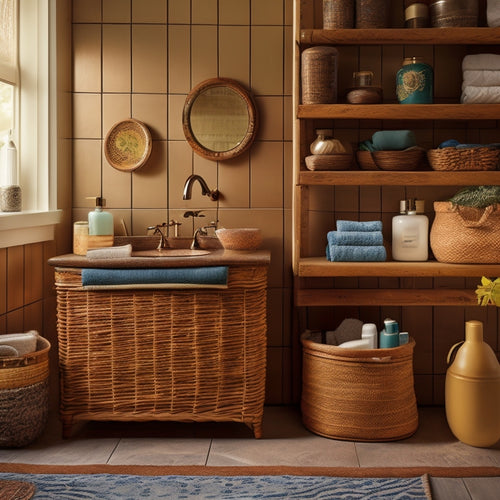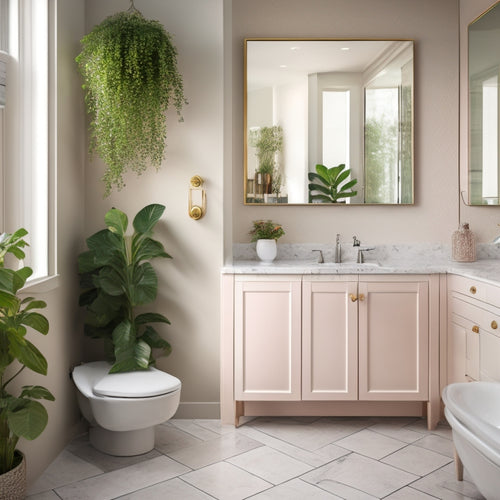
Home Design and Organization Unveiled
Share
Effective home design and organization require a nuanced understanding of the interplay between space, aesthetics, and function. It begins with careful observation of layout, lighting, and architectural features to inform design decisions. Establishing a design tone guides every decorating choice, creating a cohesive look that evokes an emotional response. By thoughtfully curating each room for efficiency and harmony, balance is achieved through visual elements, textures, and colors. As you explore the intricacies of home design and organization, discover how intentional decisions can enhance your living space, and reveal the secrets to creating a warm, sophisticated, and serene atmosphere that truly reflects your personal style.
Key Takeaways
• Careful observation of your space's layout, lighting, and architectural features informs design decisions and optimizes functionality.
• Establishing a design tone guides every decorating decision, creating a cohesive look and evoking an emotional response.
• Thoughtfully curating each room for efficiency and harmony involves defining the room's purpose and optimizing the layout for flow and ease of movement.
• Balancing visual elements, textures, and colors creates a harmonious atmosphere, impacting the ambiance and flow of traffic and conversation areas.
• Intentionally selecting lighting, texture, color, pattern, scale, and focal points elevates living spaces, creating warmth, sophistication, and promoting relaxation and serenity.
Understanding Your Space
Every inch of your home, from the soaring ceilings to the snug corners, holds the potential to be a harmonious blend of form and function. But first, you must take stock of the space you have, carefully observing the layout, lighting, and architectural features that define each room.
To optimize your space, consider the room's purpose and function, identifying areas that require attention. Note the natural lighting, electrical outlets, and architectural details, such as built-in shelves or alcoves, that can inform your design decisions.
Setting the Design Tone
A well-defined design tone serves as the North Star for your home's aesthetic, guiding every decorating decision and ensuring a cohesive look that resonates with your personal style and complements the room's unique characteristics.
Establishing ambiance is important in setting the design tone, as it evokes an emotional response and creates a sense of belonging. To achieve this, consider the mood and atmosphere you want to create in each room.
Creating cohesion is also essential, as it ties together the various design elements, such as color, texture, and pattern.
Crafting a Functional Home
In a functional home, each room is thoughtfully curated to serve a purpose, fostering a sense of efficiency and harmony that resonates throughout the entire living space. To achieve this, a focus on creating flow and maximizing efficiency in each area is crucial.
Here are three key considerations:
-
Define the room's purpose: Identify how you want to use the space and design it accordingly. This will help you determine the necessary furniture, lighting, and decor.
-
Optimize the layout: Strategically place furniture and fixtures to create a sense of flow and ease of movement. This will make the space feel more functional and efficient.
-
Select multi-functional pieces: Choose furniture and decor that serve multiple purposes, such as a storage ottoman or a desk with built-in shelving. This will help maximize efficiency and reduce clutter.
Bringinging Harmony to Rooms
By thoughtfully balancing visual elements, textures, and colors, you can create a harmonious atmosphere in each room that resonates with your personal style and fosters a sense of calmness.
A well-designed room layout can greatly impact the overall ambiance, so consider the flow of traffic and conversation areas.
Color psychology also plays a significant role, as different hues can evoke emotions and affect mood. For example, blue tones can promote relaxation, while yellow can stimulate energy.
By intentionally selecting colors and textures, you can craft a space that not only reflects your personality but also nurtures your well-being.
Elevating Your Living Space
Six essential elements – lighting, texture, color, pattern, scale, and focal points – come together to elevate your living space, transforming it into a vibrant and inviting haven that nurtures your spirit and sparks connection with others. By thoughtfully considering each of these elements, you can create a space that exudes warmth and sophistication.
Here are three key considerations to maximize comfort and create zen in your living space:
-
Layered Lighting: Combine overhead lighting, table lamps, and floor lamps to create a warm and inviting atmosphere.
-
Textured Accents: Incorporate throw blankets, rugs, and plush furniture to add depth and visual interest to your space.
-
Calming Color Palette: Choose a soothing color scheme, such as blues and greens, to promote relaxation and serenity.
Frequently Asked Questions
How Do I Balance Personal Style With Resale Value in Home Design?
When balancing personal style with resale value, incorporate neutral accents and timeless classics to create a harmonious blend. This approach allows for self-expression while appealing to potential buyers, ensuring a welcoming space that feels both personal and universally inviting.
Can I Successfully Mix High and Low-End Design Pieces in a Room?
"Picture a harmonious blend of luxury and affordability, where high-end statement pieces mingle with budget-friendly finds, creating Style Synergy. Avoid Budget Blunders by balancing contrasting elements, ensuring a cohesive look that exudes sophistication and personality."
What Is the Ideal Ratio of Decorative Items to Empty Space?
To achieve a harmonious balance, aim for a 2:1 ratio of decorative items to empty space, creating a visual hierarchy that guides the eye and provides breathing room, allowing each piece to shine while avoiding cluttered chaos.
How Often Should I Update My Home Decor to Stay On-Trend?
To stay on-trend, incorporate a seasonal refresh every 3-4 months, and consider a design evolution every 2-3 years, allowing your space to adapt to your evolving style and preferences while maintaining a sense of timeless elegance.
Are There Any Universal Design Principles That Apply to All Homes?
Universal design principles, such as balancing design elements and considering human scale, create a harmonious and inviting atmosphere in any home, fostering a sense of belonging and connection to the space.
Related Posts
-

Vintage Bathroom Storage Ideas for Large Families
You can easily boost your large family's bathroom with vintage storage ideas that marry style and function. Think rep...
-

Stylish Corner Cabinet Ideas for Bathrooms
Looking to enhance your bathroom with stylish corner cabinets? You can maximize space and improve aesthetics at the s...
-

High Road Car Glove Box Organizer Review
The High Road Car Glove Box Organizer is a top-rated solution for keeping vehicle documents and essentials neatly org...


